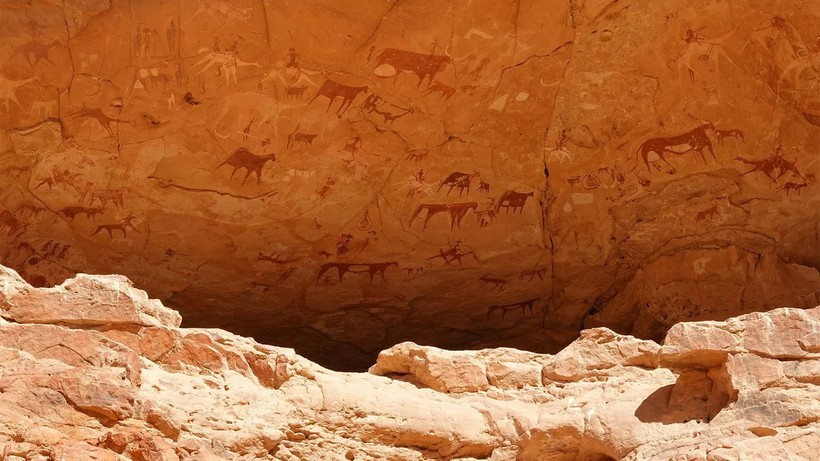
The Ennedi Massif Plateau is located deep in the Sahara Desert of Chad, famous for its spectacular rocky mountains, vast sand sea and “little explored second only to the Moon”. There are many traces of prehistoric humans here, with up to 75% of the area still unexplored.
“Desert Wall”
Ennedi Massif is located in the Northeast of Chad (a country in Central Africa), has an area of about 60 thousand square kilometers and the highest peak is 1,450m above sea level. The distance from the capital N’Djamena to Ennedi Massif is up to 1 thousand kilometers, the road is bumpy, it usually takes about 4 days to get there.
Chad is not a peaceful country. For decades, this place has been mired in coups, ethnic conflicts and war with Libya. Because it is both so remote and located in a war-torn country, Ennedi Massif is rarely accessed by scientists, it is estimated that 75% of the area is still out of sight of researchers.
Although there is little documentation, Ennedi Massif is still famous worldwide thanks to its nickname “desert wall”. Its landscape impresses with its long, towering rock ranges, diverse shapes, and no trees growing due to extreme drought. From a distance, these rows of rocks look like a wall across the desert.
Up close, the “desert wall” is not seamless. According to speculation, wind and rain are the agents of distribution and shaping. Over millions of years, they carved rocks into towers, domes, columns, walls, rocky mountains…
World Cultural Heritage

More than 7 thousand years ago, Ennedi Massif was a large, lush steppe area with an annual rainfall of about 250mm/year. However, around the middle of the sixth century BC, rainfall gradually decreased. In the 5th century, it was only 150mm/year and in the 3rd century it was as low as 50mm/year.
Before becoming a desert land, Ennedi Massif was one of the areas inhabited by prehistoric people. According to archaeological research, they may have appeared here since around 8000 BC, then settled densely from around 5000 BC onwards, with many groups of hunters and gatherers, knew how to make pottery and enjoyed art of painting.
The “desert wall” with its smooth, high and wide rock surfaces is a favorite place of prehistoric artists. They mainly painted people and animals according to real-life prototypes, leaving behind paintings and stone engravings showing everyday life. It is a scene of people working with livestock, hunting, running and jumping…
Among the drawings – engravings, there are more men than women, domesticated animals more than wild animals. The lower the age, the more detailed the paintings reveal about everyday life, showing the process of developing tools, intelligence… such as knowing how to make chariots and use horses to pull carts, and detecting genetic diseases. …
“For us, Ennedi Massif is like an open history book left by our ancestors,” shared Angèle Aloumbe – African Parks employee. In Ennedi Massif there are no houses or roads, almost no people. “Every time I come here, I feel like I’ve traveled back in time to BC, silently admiring the works of art on the rocks and being moved to tears,” he continued.
Pristine world

Just like Aloumbe said, Ennedi Massif is one of the most pristine lands in the world. Thanks to its location so deep in the desert, it is almost out of sight of humans. “When an Italian archaeologist came here, within half an hour, he found a piece of pottery dating back 7 thousand years,” tour guide Andrea Bonomo said.
In 2001, in the western part of Ennedi Massif, a 7 million year old primate skull was discovered, named Toumaï. Compared to Lucy in Ethiopia, which is only 3.2 million years old, it is much older. In addition to Toumaï, archaeologists also found other fossils of the same species, proving that Toumaï is not a special case. Some people began to believe that the cradle of humanity was likely Chad, not the Rift Valley (Ethiopia).
Despite being hot and dry, Ennedi Massif is still home to many types of flora and fauna. Hampered by security, road, and war issues, researchers have only confirmed that it has at least 199 migratory bird species that take a break while flying by. In the pools, alleys, and lakes of Ennedi Massif, desert crocodiles grow. They are characterized by their short bodies, earning them the nickname “round crocodiles”.
Thanks to camera traps, scientists discovered that in Ennedi Massif there is a population of rare North African ostriches living. They expect that species considered extinct such as the scimitar-horned antelope, Sudanese leopard, Ennedi tiger… are also surviving somewhere on this remote plateau.
In 2016, Ennedi Massif was recognized by UNESCO as a World Heritage Site. Since 2018, it has been co-protected and exploited by African Parks in cooperation with the Government of Chad, especially tourism potential. In 2019, 50 square kilometers of Ennedi Massif were designated by Chad as a cultural and natural reserve.
2 “nail houses” refused 6 billion VND in compensation, causing the highway to “split in half” in China: Electricity and water were cut off, travel was difficult, but they were determined not to relocate.




